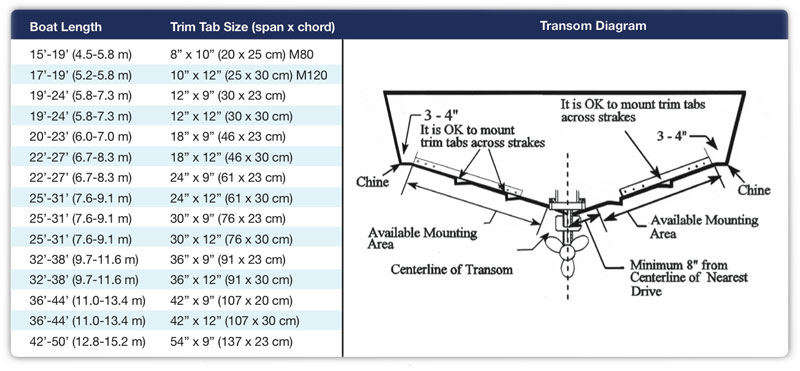Selecting The Right Trim Tabs
Proper sizing is the key to getting maximum performance from trim tabs. The lift that trim tabs produce is essentially a function of their surface area. Keep in mind that a trim tab with more surface area will produce lift more efficiently than a tab with less surface.
A trim tab with less surface area must be deflected to a greater angle to provide the same amount of lift as a larger tab at the same speed. The larger tab is more efficient as it will present less frontal area to the water flow thus producing less drag than a smaller tab deflected to a greater angle. The boat with smaller tabs will “run out of tabs”, while a boat with properly sized tabs can operate at lower speeds and still run efficiently. In general it is more efficient to fit tabs with longer span (side to side measurement). The longer span along the transom provides a “fresh” flow of water along the entire length of the tab. Wider chord tabs (fore to aft measurement), while increasing lift, “use” the water longer allowing more of it to escape from the sides as it flows aft. However wider chord trim tabs are an option on heavy boats that require as much lift as can be obtained, or boats with transom shapes that will not allow a long span. Boats that have outboards mounted on brackets, a dinghy or personal watercraft on stern davits, or any other feature that shifts the center of balance aft require more lift and may be candidates for 12” chord trim tabs. Vessels with lower cruising speeds (under approx. 15 mph) and semi-displacement hulls also benefit from the maximum lift provided by 12” chord widths.

A starting point for sizing trim tabs is obtained by providing at least one inch of span for every foot of boat length. Other factors such as top speed should be considered as well, boats over 50 MPH should look at Bennett Sport Tabs or Premier Series Properly installed trim tabs have no effect on a boat’s performance when fully retracted. Trim tabs require a run of constant deadrise angle at the junction of the transom and the bottom of the boat. Generally, trim tabs are best placed outboard, usually starting 3 to 4 inches from the chine and run towards the keel. The further outboard the tabs are placed the more force they will be able to exert when making side to side corrections. If the surface area of the tabs is concentrated too close to the centerline of the boat the side to side corrective value of the tabs, relative to the fore to aft trim, is diminished.
In the case of inboards, the complete run from chine to keel may often be utilized if it is an unbroken span of the same angle. Protrusions such as strakes may be bridged provided there is no change in deadrise angle on both sides. In transoms with a deadrise that has multiple angles try to use one run of deadrise (preferably outboard). If this is not possible, mount the trim tabs so they maintain the best possible contact with the water flow.
On boats powered by outboards or sterndrives it is necessary the trim tabs not be placed too close to the drive unit to avoid disturbing the water flow to the propeller thus causing ventilation. This is usually no closer than 7”.
Of course if you have any questions just contact our Client Services team +1(954)427-1400 or [email protected]. and they will be delighted to help.
